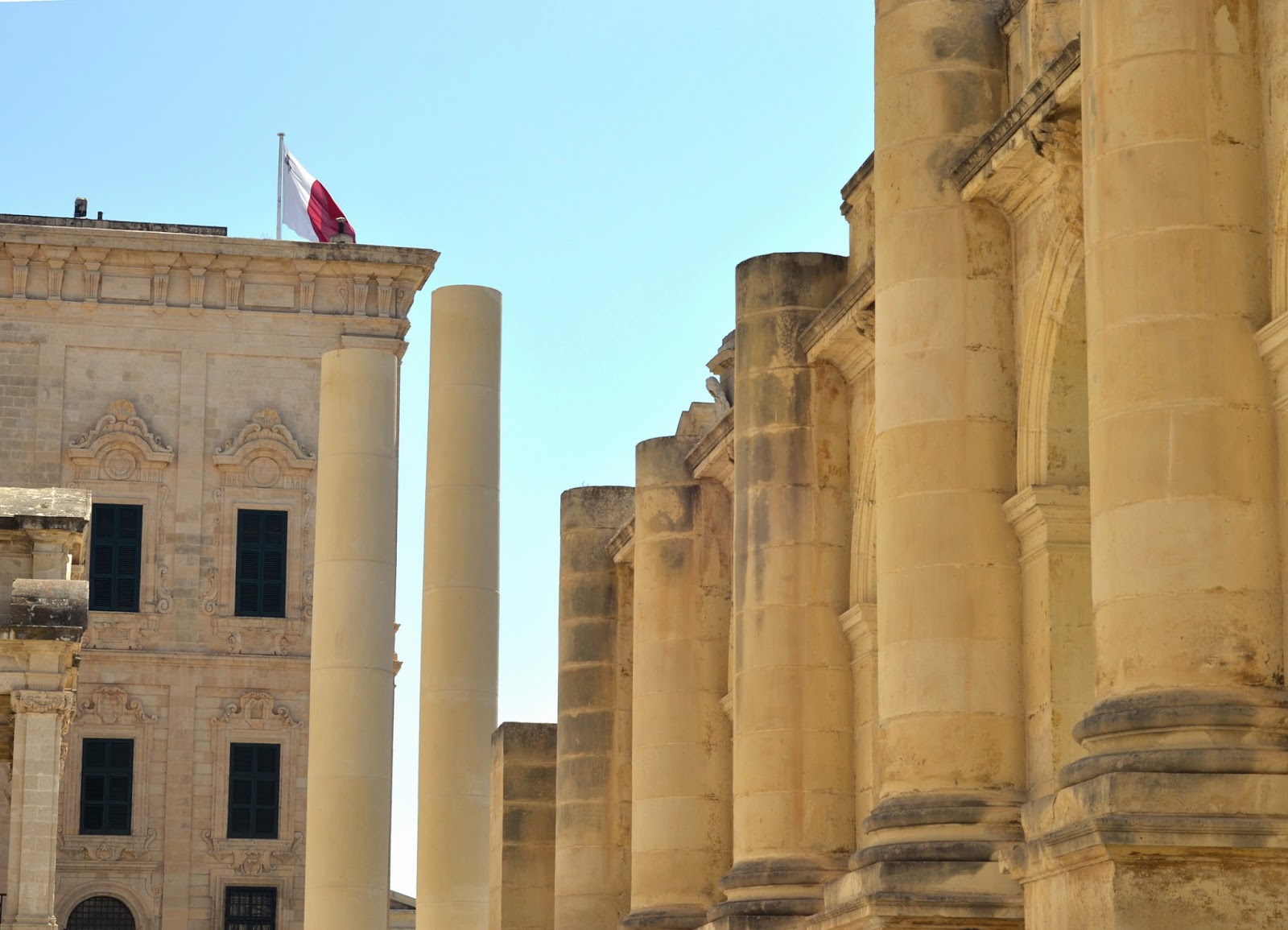When it came to pick our holiday destination, we knew only a couple of things for sure: we wanted to be by the Mediterranean sea, we wanted hot temperatures and we wanted art and history along with blue water. Malta seemed the right choice and definitely it has been so, plenty of places to visit, activities to do, fascinating architectures and wild, rugged nature. Bottom line: I've taken something like 500 pictures! Hard to select them, but here it is my first photo-post dedicated to the Malta island and the beautiful, never-to-miss locations you can discover there.
*
Quando si è trattato di decidere dove andare in vacanza, avevamo solo un paio di certezze: volevamo essere sul Mediterraneo, al caldo e volevamo essere circondati da arte e storia, oltre che da acque blu. Malta sembrava la scelta giusta e decisamente si è rivelata tale, così piena di luoghi da visitare, attività da fare, architetture affascinanti e natura aspra e selvatica. Morale della favola: ho fatto qualcosa come 500 foto! Difficile fare una selezione, ma ecco il mio primo photo-post dedicato all'isola di Malta e alle splendide località assolutamente da non perdere che si possono scoprire.
A bit of history...
As many other islands and countries in the Mediterranean area, Malta as well had been dominated by the Arabs. Then, after the Normans arrived, it became Sicilian territory. Then, in the 16th century, Emperor Charles V gave the islands to the Knights Hospitaller who almost immediately had to withstand the Siege by the Ottomans. Then, Napoleon came and, finally, after Waterloo and the Treaty of Paris Malta became part of the British Empire, achieving full independence only in 1964.
Troubled history trickling from every crack in the old, golden buildings and from every water mark in the colourful luzzus. The secret of its charme.
Valletta, the city of the Knights
The capital of Malta Republic was named after Jean de Valette, the victorious Grandmaster of Knights Hospitaller during 1565 Great Siege. The city is the smallest and the second southernmost capital in the EU and it's simply a beauty. Not a surprise, it's been nicknamed Superbissima (Most Proud). I walked speechless through its narrow and sometimes steep streets, amazed by the Baroque facades of churches and palaces, amused by recurring Sicilian names on shop signs in front of red, British public phone boots. I felt overwhelmed by St. James Cavalier walls and the Royal Opera Hous Ruins Theatre, I enjoyed the luxurious vegetation in the Upper and Lower Barrakka Gardens, I breathed as I had never done that before watching the blue sea from the Saluting Battery terrace and Fort St. Elmo. I stayed still, in complete awe, in front of Caravaggio's Beheading of St. John in St. John Co-Cathedral.
*
Un po' di storia
Come tanti altri paesi e isole del Mediterraneo, anche Malta subì la dominazione araba, fin quando, con l'arrivo dei Normanni, non entrò a far parte del Regno delle due Sicilie. Poi, nel Cinquecento, l'imperatore Carlo V concedette l'isola ai Cavalieri Ospitalieri che, quasi immediatamente si ritrovarono a dover resistere all'assedio degli Ottomani. Quindi arrivò Napoleone e, finalmente, dopo Waterloo e il Trattato di Parigi, Malta diventò parte dell'Impero Britannico, conquistando completa indipendenza solo nel 1964.
Una storia travagliata che trasuda da ogni crepa nei vecchi muri di tufo dorato dei palazzi storici o da ogni segno lasciato dall'acqua sul legno colorato dei luzzu. Il segreto del suo fascino.
Valletta, la città dei Cavalieri
La capitale della Repubblica di Malta deve il nome a Jean de la Vallette, Gran Maestro degli Ospitalieri durante il Grande Assedio del 1565. La città è la più piccola capitale europea e la seconda più meridionale, ed è semplicemente una perla. Non stupisce che sia stata soprannominata Superbissima. Io ho camminato senza parole tra le sue stradine strette e a volte ripide, affascinata dalle facciate barocche di chiese e palazzi, divertita dai nomi siciliani sulle insegne dei negozi proprio di fronte alle tipiche cabine telefoniche rosse inglesi. Mi sono sentita smarrita dall'imponenza delle mura di St. James Cavalier e del Royal Opera House Ruins Theater, ho trovato pace tra la lussureggiante vegetazione degli Upper e Lower Barrakka Garden, ho respirato a pieni polmoni guardando, dalla terrazza della Saluting Battery e da Fort St. Elmo, la distesa azzurra del Mediterraneo. Sono rimasta immobile, in assoluta meraviglia, di fronte alla caravaggiesca Decollazione di San Giovanni all'interno della Co-Cattedrale di San Giovanni.
Birgu and Grand Harbour Marina
We couldn't visit much of Birgu, but we had a look around as we headed to Grand Harbour Marina to get on board of the sailing yacht we spent the most of our time in Malta. The harbour is the most fascinating I've ever seen so far, with rows of sailing boats and some bigger yachts floating gently in the narrow, deep creek between Senglea's peninsula and Birgu's promontory. Birgu became Malta's capital city as soon as the Knights arrived in 1530, as its harbour suited better the needs of the Order than the former capital, Mdina, being it fortified though inland. The ancient city reminded me a lot, again, some old, little villages in Sicily or in Calabria, where old tanned man share bread and olives and a glass of wine sitting at scrap wooden table right outside the bars.
In the same promontory there's also Fort St. Angelo, where Caravaggio was incarcerated after aggressing a fellow Knight of the Order.
*
Birgu e il Porto Grande
Di Birgu non abbiamo potuto visitare granché, ma siamo riusciti a dare una sbirciatina quando siamo andati al Porto Grande a imbarcarci per la nostra settimana di vela. Il porto è il più bello e affascinante che io abbia mai visto, con queste file di barche a vela e qualche yacht più grande schierate nella profonda insenatura tra la penisola di Senglea e il promontorio su cui sorge Birgu. Questa fu eletta capitale di Malta non appena gli Ospitalieri arrivarono sull'isola, nel 1530, poiché molto più adatta alle esigenze dell'Ordine rispetto alla precendente capitale, Mdina, fortificata sì, ma nell'entroterra.
La città vecchia mi ha ricordato immediatamente certi villaggi siciliani e calabresi, in particolare Rossano, dove vecchi uomini con la pelle cotta dal sole condividono pane, olive e un bicchiere di vino seduti a tavoli di legno fuori dalle trattorie.
Sullo stesso promontorio si trova, inoltre, Forte Sant'Angelo, il luogo in cui Caravaggio, dopo l'aggressione a un altro Cavaliere di Malta, venne incarcerato.
Mdina
Before the Knights of the Order of St. John arrived, Mdina was the capital of Malta. The medieval city is still all enclosed in high fortified walls and is known as the Silent City, and as far as I could see it is indeed, having visited it at midnight. I guess it's wonderful in daylight, but I really loved the magic of walking through its streets in the dark and in the silence.
Marsaxlokk
Luzzus are the traditional, colourful Maltese boats carrying a pair of painted eyes on their bow, believed to protect the boat from dangers. You may see them almost everywhere near the coast, but it will never compare with the dozens moored in Marsaxlokk Bay. Marsaxlokk literally means sirocco's harbour and is a traditional fishing village along the south-eastern coast of Malta, famous for its seafood restaurants and its Sunday market.
*
Mdina
Prima dell'arrivo dei Cavalieri dell'Ordine di San Giovanni, la capitale maltese era Mdina. La città medievale è tuttora interamente circondata da mira ed è conosciuta come la Città Silenziosa. E da quel che ho potuto osservare durante la mia visita notturna lo è davvero. Immagino sia stupenda alla luce del giorno, ma è difficile descrivere la magia di passeggiare per quelle strade col buio e nel completo silenzio.
Marsaxlokk
I luzzu sono le tipiche imbarcazioni maltesi, tutte colorate e con i caratteristici occhi dipinti sulla prua, che i pescatori credevano proteggessero la barca dai pericoli del mare. Se ne possono vedere praticamente ovunque vicino alla costa, ma niente può eguagliare le decine ormeggiate nel porticciolo di Marsaxlokk. Marsaxlokk significa, letteralmente, golfo dello scirocco ed è un tradizionale paese di pescatori lungo la costa sud-orientale, famoso per i suoi ristoranti di pesce e per il suo mercato domenicale.
Popeye Village, the Blue Grotto and Gnejna Bay
The high, rocky cliffs outlining Malta's coast are from time to time interrupted by small bays, creeks, grottos. During our sailing we stopped at the Blue Grotto, the name is self-explicative, Gnejna Bay, surrounded by grey-orange cliffs, and Popeye Village. The bay is occupied by the Film Set of 1980 movie "Popeye", starring Robin Williams, and it is now a tourist attraction with a tiny beach and the coloured, crooked wooden houses created for the Hollywood production. Dreamy imagining of Popeye and Bluto fighting for Olive in front of this blue sea.
*
Popeye Village, Blue Grotto e Gnejna Bay
Le alte scogliere rocciose che disegnano la costa maltese sono interrotte ogni tanto da calette, insenature e grotte. Durante la nostra navigazione ci siamo fermati al Blue Grotto, la grotta blu, nome direi autoesplicativo, Gnejna Bay, circondata da scogliere grigio-arancioni, e il Popeye Village. La baia è occupata dalla scenografia del film del 1980 "Braccio di Ferro", interpretato da Robin Williams, ed è ora una vera attrazione turistica, con una piccola spiaggia e le casette storte e colorate create per la produzione hollywoodiana. E la fantasia vola, a immaginarsi Braccio di Ferro e Bluto litigare per Olivia davanti a quel mare così blu.
Again, stay tuned. Gozo and Comino reportage is coming soon!
*
E ancora una volta, stay tuned. Il reportage su Gozo e Comino sta per arrivare!















Recupero solo ora Malta! Che bellezza non la conoscevo :)
RispondiEliminaMerita davvero!
Elimina